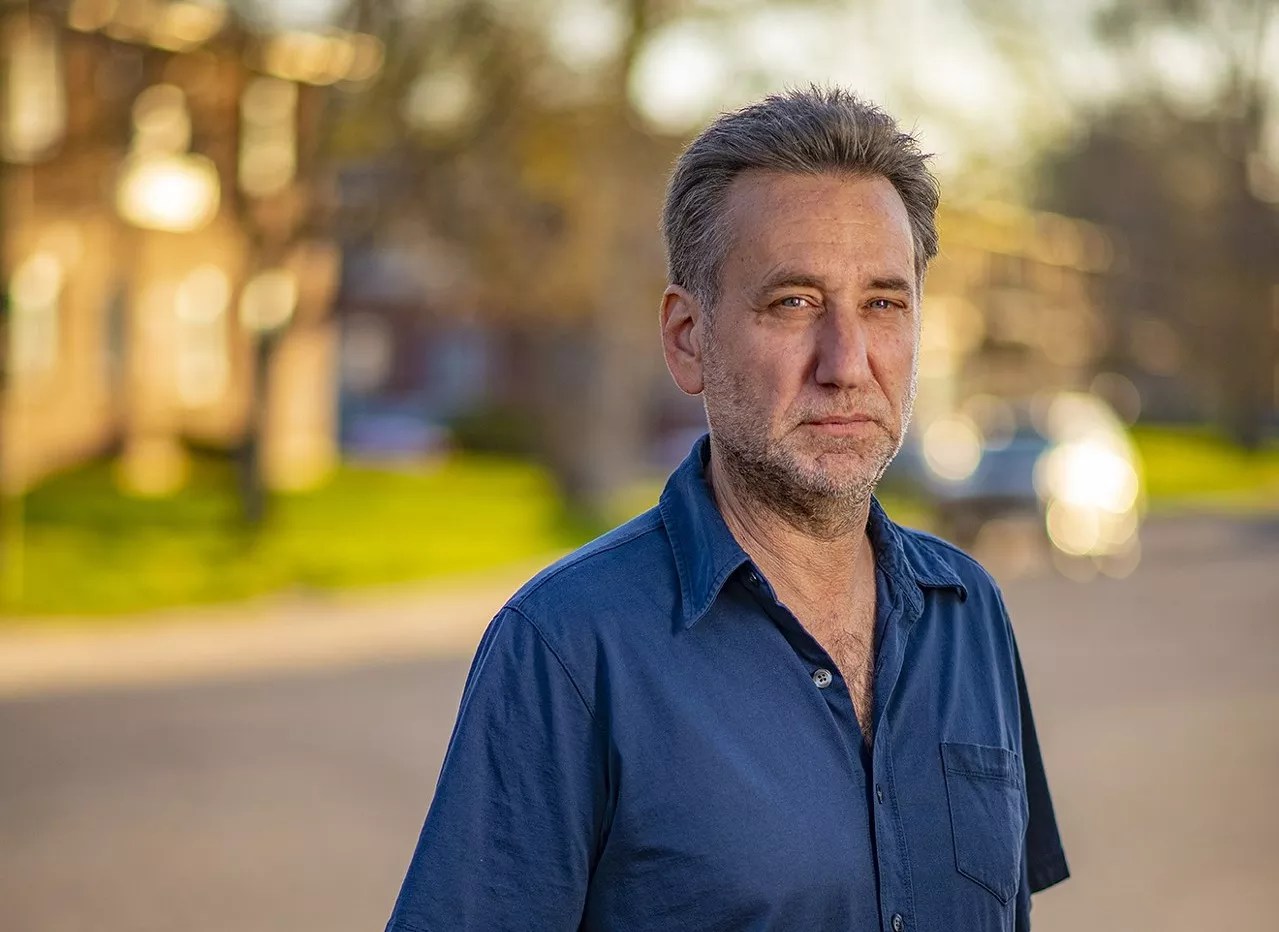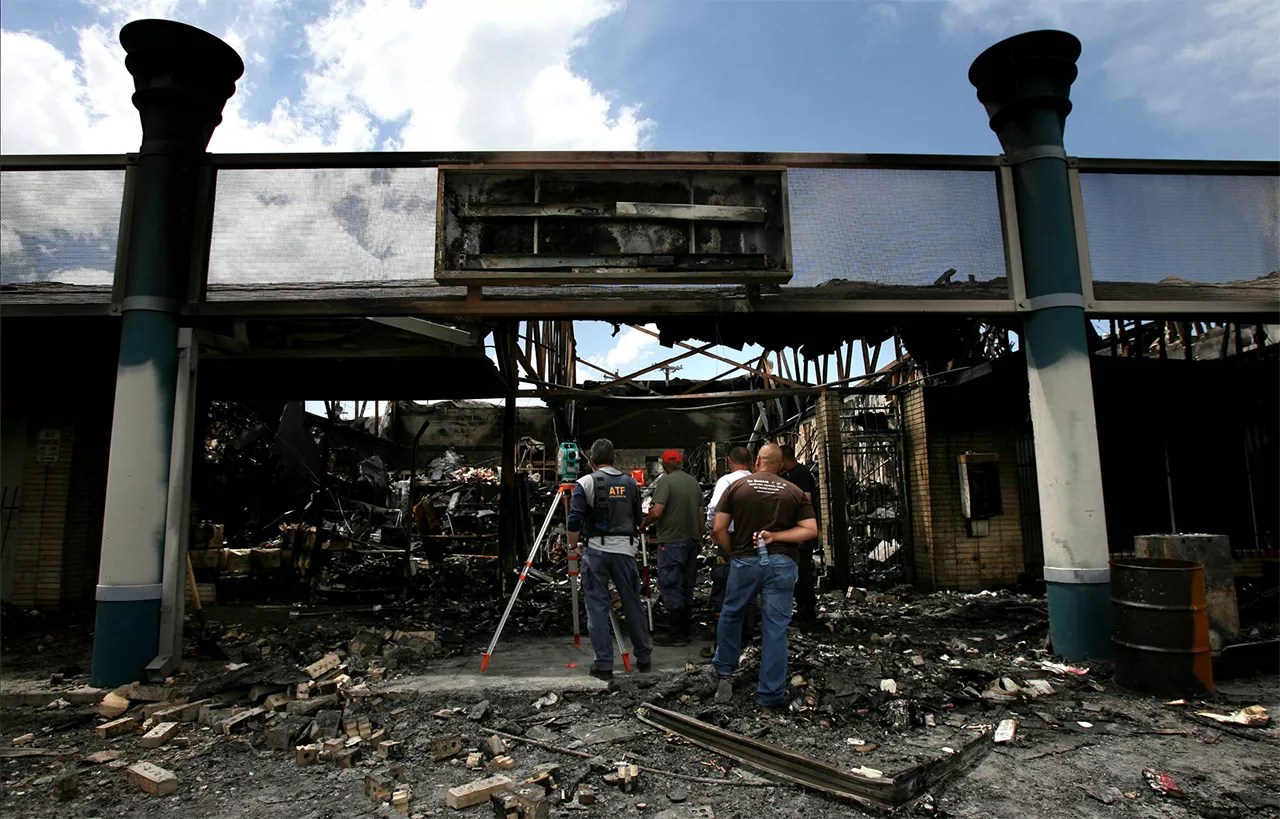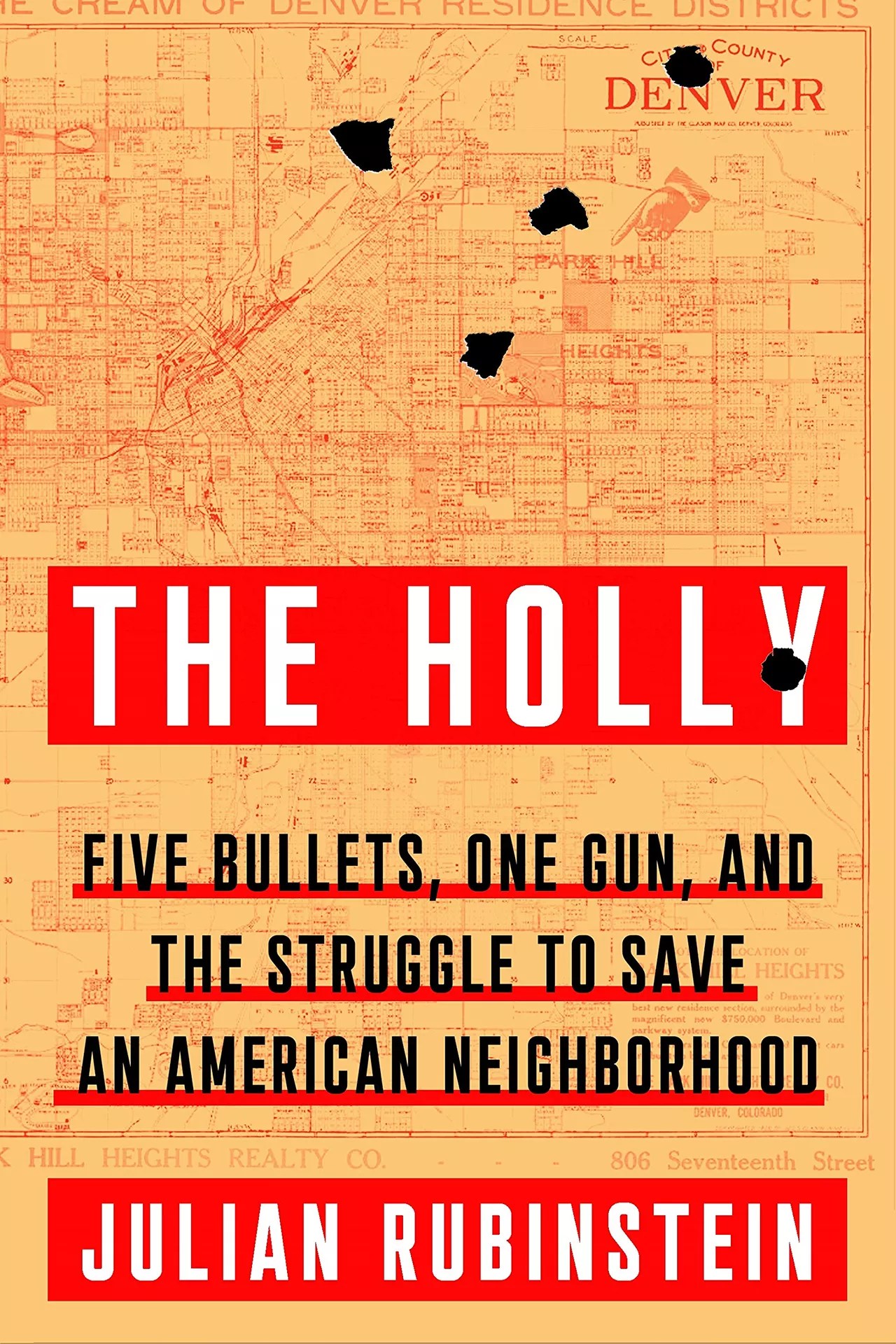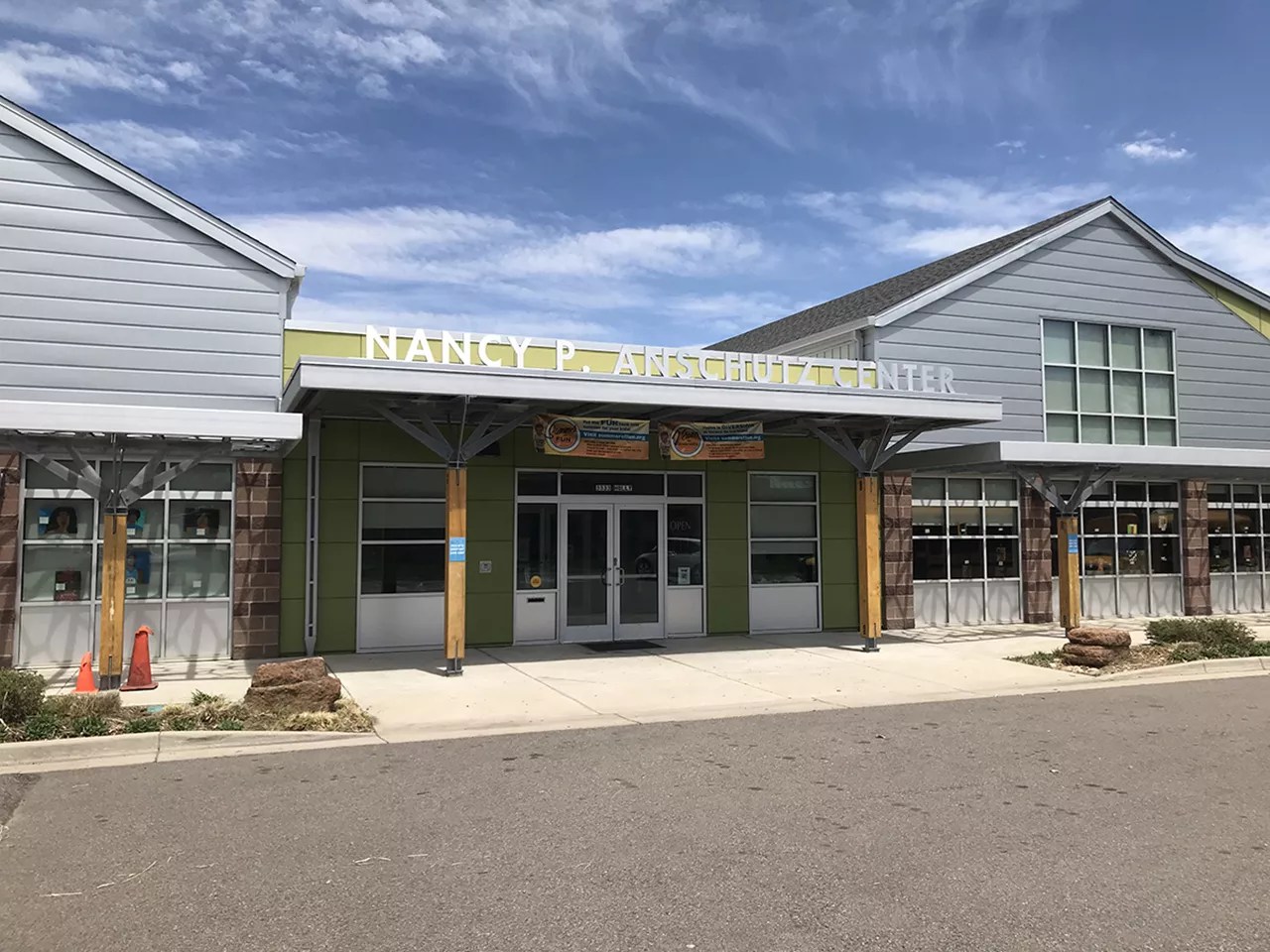
Evan Sem

Audio By Carbonatix
In late September 2013, freelance journalist Julian Rubinstein was living in New York when he picked up a copy of the New York Times and saw a headline about his hometown: “After Violence Interrupts Progress, a Struggle Ensues in Denver.”
The story, about the aftermath of a shooting in Holly Square, a block in Northeast Park Hill that had once been a neighborhood hub of Black-owned businesses and a landmark of the civil rights movement, chronicled the tragic – and baffling – tale of Terrance Roberts, an anti-gang activist who was facing life in prison for attempted murder.
A former leader of the Denver Bloods, Roberts had gone by ShowBizz in his gang days back in the ’90s, when he was dealing drugs and beating and shooting at Crips. In prison in the early 2000s, he found God during a chance encounter with a Crip, renounced his Bloods affiliation and turned into an anti-gang crusader.
Back outside in 2005, Roberts founded the nonprofit Prodigal Son. Later, he formed the Camo Movement, another anti-gang initiative that involved painting swaths of Holly Square camo colors and recruiting Bloods and Crips to renounce gang life and fight for community power through unity, camouflage fashion and music production.
Through Prodigal Son, Roberts helped drive the citywide effort to turn Holly Square, which had become a Bloods stamping grounds, into a safe community space. He raised funds to build basketball courts, led an after-school program, recruited funders to build a youth center on the block, and attempted to take power away from the gangs with policy and politics rather than violence. Through it all, he reached out to local Bloods and Crips, attempting to save them from the drug-dealing, machine-gun-toting, bloody life he’d once lived.

The Holly shopping center was torched by Crips in 2008.
Denver Public Library via the Rocky Mountain News/Preston Gannaway
Roberts became a darling of the city’s political machine, and he helped pave the way for largely white-run nonprofits with close ties to law enforcement to take root in the Holly. During the process, however, he started feeling used and began blasting politicians, nonprofits and developers, accusing them of conspiring to gentrify his longstanding Black community, icing him and other Black leaders out of the future of the Holly. He refused to work with law enforcement on well-funded anti-gang initiatives that would have paid his rent and kept him and his family fed, because he refused to compromise his values.
The nonprofit leaders who had praised Roberts for years suddenly started dropping him from programs. They quit responding to his letters. Prodigal Son funding was drying up, and Roberts was on the verge of closing his nonprofit, housed in a rundown corner office across from the Horizon Lounge in the Holly.
With a grand new Boys & Girls Club facility funded by billionaire Phil Anschutz slated to open in the Holly in early October 2013, Roberts had organized a neighborhood peace and unity rally on September 20. That day, several Bloods harassed him, accusing him of being a snitch. Believing his life was in danger, Roberts put a 9mm pistol in his truck in case there was trouble.
And there was.
As Roberts and his friends were setting up for the rally outside the office he shared with then-Senator Mike Johnston, who was holding an event of his own that day, a group of Bloods moved in to attack Roberts. He grabbed his pistol and shot 22-year-old Hasan “Munch” Jones multiple times, claiming self-defense. Jones, whom Roberts had tried to recruit for the Camo Movement and had even taken to a Denver Nuggets game, was paralyzed in the shooting.
Roberts’s carefully rebuilt life took a hit, too. His former backers distanced themselves; as they pointed to the bright future of the Holly, they barely acknowledged Roberts’s contributions.
Meanwhile, then-District Attorney Mitch Morrissey, who had prosecuted Roberts when he was a Blood and later awarded him for his anti-gang efforts, was building yet another case against the Prodigal Son founder. Even if Roberts could prove self-defense and dodge a life sentence, he had been caught with a gun in his hand and had openly explained why he shot Jones. As a felon, he was prohibited from carrying a firearm. How could he get out of that charge?
In New York, Rubinstein was nagged by a critical question that also plagued those who knew Roberts: “Why did Terrance shoot Hasan?”
To get the answer, Rubinstein wrote to Roberts, who was out on bond, then flew to Denver and met him at an International House of Pancakes. The sprawling conversation that ensued, covering everything from politics and hip-hop to gang life and activism, captivated the journalist.
“I was absolutely riveted by just everything about him,” recalls Rubinstein. “He’s an absolutely fascinating person who just is practically thumping and beating with the history and the symbol of so many things that you can feel coming out of him. And he also had a very different story about what he thought happened on the day of the shooting, which was not represented anywhere in the media.”
According to Roberts, Bloods were working as informants for law enforcement and had been part of a concerted effort to destroy him because of his political views and the power he had gained in the Holly. His theories were tied to long and well-documented histories of government surveillance of activist movements both federally and in Denver.
“I didn’t know what to think about it, because it sounded kind of conspiratorial, and some of it didn’t even make sense,” recalls Rubinstein. “But he clearly thought he had been purposefully pushed out – targeted. He seemed to think any number of people and/or entities were involved, including, he was saying, informants in the neighborhood. And I just wanted to know a lot more.”
Rubinstein started checking out Roberts’s story, interviewing gang members, anti-gang activists, city officials, and residents of Northeast Park Hill.
“The story was just too all-consuming to try to report from afar,” Rubinstein explains. With his track record as an author and investigative journalist, he secured a book deal with Farrar, Straus and Giroux to write THE HOLLY: Five Bullets, One Gun, and the Struggle to Save an American Neighborhood; the publisher believed the story had national relevance because it mirrored so many of the issues with law enforcement plaguing Black neighborhoods nationwide. Rubinstein returned home to Denver to live with his mother and continue his research on the ground. He also decided to make a documentary about Roberts’s story, bringing a cinematographer along for many of the interviews.

THE HOLLY: Five Bullets, One Gun, and the Struggle to Save an American Neighborhood cover.
Farrar, Straus and Giroux
Unlike the articles he read in the Denver media, Rubinstein didn’t want to shine undue light on the city’s power brokers, and instead spent most of his time reporting on what he calls “invisible Denver” – the neighborhood communities, activist circles and even gangs that are so often ignored by the mainstream press.
“What I wanted to do – and it turned out to be even more important than I first realized – was to tell this story mostly from the perspective of the people who were not represented over the years in those types of stories,” he says. “It was so hard to really find material about this kind of neighborhood that wasn’t from law enforcement sources.
“So I did realize that I wanted to go deep. And as I started to get deeper, by the way, people like law enforcement in Denver, who first were happy to talk to me, suddenly didn’t want to talk to me,” he continues. “So I was like, okay, you know, maybe, the truth is your enemy? And if so, what does that mean?”
To find out, Rubinstein showed up wherever he could: community meetings with law enforcement, gang funerals, protests, the trials of Roberts and later Jones – who, even after he was paralyzed by Roberts’s bullets, had been charged but not convicted of a drive-by shooting and later charged and convicted for brutally killing a two-year-old girl.
As a white man, Rubinstein had trouble initially building trust in Northeast Park Hill’s largely Black community, which had been so affected by the shooting. They asked why he was the one to tell the story. Nobody else was in line, Rubinstein would respond, and he felt a duty to correct the record.
“I was told later on in the process by a few people that it turned out that actually being white was an advantage,” Rubinstein says. “And this is a sad part of the reality in these neighborhoods – Northeast Denver and in gang neighborhoods across the country that are over-policed and have been for decades – which is that there’s an incredibly high level of mistrust, particularly among Black men.
“And it’s because there are so many informants in these neighborhoods that you really don’t know if your friend is who he says he is,” he continues. “If the guy at the store is who he says he is. If your family member is. And if suddenly a guy you hadn’t seen in a while – you liked – but now he’s coming around: Is there something more to that? This is the unfortunate level of concern and paranoia that exists. And there was less likelihood that I was an informant than someone else who might have been African-American. So that was a surprising thing that helped me.”

Terrance Roberts recruited the Boys & Girls Club to help revive the Holly.
Kyle Harris
The more Rubinstein dug into the story, the more he realized that the conditions that led to the shooting went back fifty years, to the civil rights movement, to the turbulent attempt at integrating Park Hill, to a longstanding history of police violence against the neighborhood’s Black community. He researched the rise of street gangs – both early, Denver-born gangs and the Bloods and Crips that had started in California – and what their relationships with law enforcement had been like.
He mined both Jones’s and Roberts’s personal and family histories, digging into court documents, speaking at length with their families, friends and even enemies. “I scoped Terrence Roberts 360,” he says. “People have said to me, ‘You probably know him better than he knows himself.’ I don’t know. But I definitely dug into everything.”
The result is a complex and sympathetic portrait of Roberts: a top student in elementary school who became a violent and powerful Blood; a community activist prone to hubris, depression and violence – both at home and in the streets – and a leader who, despite seemingly impossible circumstances, has not seen his last act.
Rubinstein wrapped his reporting this past February, after a summer of racial strife and protests against killer cops during which Roberts re-emerged as a leader in the racial justice movement. The book ends in the middle of Roberts’s latest criminal case: a charge that he incited people to riot during protests against the police killing of Elijah McClain in Aurora.
Roberts, who prefers a reformist approach over police abolition and spent much of the protests calling for non-violence and opposing vandalism, is confident that all of the charges against him will be dismissed; last week, the last felony charges were dropped. But Rubinstein suggests that the recent charges are further evidence that law enforcement’s approach to Roberts has long been about politics and curbing his power, not actual crimes.
Through his reporting, Rubinstein unearthed troubling evidence that Denver and federal law enforcement recruits pay active gang members to work as informants; others, he writes, have been put in charge of government-funded anti-gang organizations with the blessing of celebrated anti-gang activist Reverend Leon Kelly. And all of this has been done with little scrutiny from the press, which Rubinstein argues has a cozy relationship with police and city officials (in one case, a reporter working on the Roberts story was married to an ATF agent working a similar beat).
Rubinstein also tracked the history of federal anti-gang funding coming into Denver and asks whether there is an “urban-war industrial complex,” where cities and NGOs receive significant funds when gang conflict spikes and bodies fill the streets. “I know from my research that $16 million from the DOJ and the CDC floated to Denver to both fight gang violence and study gang violence. And yet, while that began with Denver’s gang violence at an all-time low, it has, despite all that funding, gone up every year. And meanwhile, [Roberts], the guy who had the most success fighting it, is again facing prison time and unable to work in the anti-gang program, and gang leaders are getting public money and being supported by the city.
“In a lot of cases, these guys have criminal cases against them that are just being overlooked, brushed off, dismissed,” Rubinstein claims. “I mean, people talk about, ‘Oh, well, you know, the system is really against African-Americans.’ Well, not these guys. If you’re a gang leader in Denver, this system apparently is working for you, I guess. God, I looked at the list of cases for these guys that, like, nope, if I would have committed any of those crimes, I wouldn’t be talking to you; I’d be in prison. So, you know, the system is upside down.”
That troubled Rubinstein.
“It’s not a very comforting thing to return to your hometown of Denver, Colorado, and to report on a book and find out about paid gang hits, and you actually feel less safe calling law enforcement to report it. So you don’t.
“I’ve reported around the world,” Rubinstein continues. “This is the first time I’ve actually done a story in Denver. And I have been in places where I felt: ‘Man, okay, my flight’s in two days. I gotta just get the hell out of here.’ I did not think that I’d be in Denver, feeling like I was in some totalitarian state or something, with the police being connected to murderous gang leaders and informants.”
While there are details about his life in the book that Roberts is not thrilled to see in print, he says he’s supportive of the project because it does such a good job exposing corruption in Denver’s political machine.
Roberts gave Rubinstein open access to his life and had no expectations that he would get to select what was included.
“It’s not a puff piece on me,” Roberts says – and he’s right. “There’s things about my life that’s not everyone’s business. That’s what happens with that type of journalism going on. … There are parts of it I wish I could have did better in, but I’m also proud of the overall product, because I don’t have anything to be ashamed of. We’re trying to do a good thing the best we can. I think it shows that. I’m happy about it. Of course, I wish everything could be perfect with some sprinkles on top, but that’s not the reality.
“There’s going to be other people who don’t like what’s coming out in it,” he adds. “But that’s what happens when you’re dealing with gang violence, with politics. It’s messy stuff sometimes. My message to everybody is to do better. If you don’t like what Julian uncovered in this book, let’s decide to do better.”
For more information about the author, visit Julian Rubinstein online. Read a chapter of THE HOLLY here.